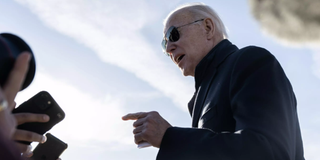Balloons and missiles: US-China tension turns to arms race

US President Joe Biden speaks to reporters about the Chinese spy balloon after arriving at Hagerstown Regional Airport in Hagerstown, Maryland, on February 4, 2023.
Chinese officials were last weekend downplaying the incident in which a balloon strayed into the US airspace. But Washington reacted quickly, sending a fighter jet to shoot down the ‘spy balloon which it described as “unacceptable violation” of American sovereignty.
After initial hesitation, Beijing admitted ownership of the "airship," but said it was a weather balloon that had been blown off course.
“The airship is from China. It is a civilian airship used for research, mainly meteorological, purposes,” China's foreign ministry said in a statement, hours before Washington shot it down.
“The Chinese side regrets the unintended entry of the airship into US airspace due to force majeure,” it said, using the legal term for an act outside of human control.
Whether the balloon was unintended or harmless has not been accepted by Washington, which saw it as a territorial violation and a signal of Chinese aggression. But it may also signal the future rivalry between the two biggest economies: an arms race.
The balloon first entered US airspace over Alaska on January 28, Pentagon officials told reporters Saturday, before drifting over Canada and then back into the United States days later.
The craft spent several days flying over North America, ratcheting up tensions between Washington and Beijing, before it was targeted with a missile shot from an F-22 plane, Pentagon officials said, falling into relatively shallow water just 47 feet (14 meters) deep.
US Secretary of Defense Lloyd Austin called the operation a "deliberate and lawful action" that came in response to China's "unacceptable violation of our sovereignty."
Saturday afternoon was the military's first chance to take on the balloon "in a way that would not pose a threat to the safety of Americans," a senior defense official told reporters, while still allowing authorities to collect the fallen debris from US territorial waters.
President Joe Biden, who earlier Saturday had promised "to take care" of the balloon, congratulated the fighter pilots involved.
"They successfully took it down. And I want to complement our aviators who did it," Biden told reporters in Maryland.
The controversy erupted Thursday, when American officials said they were tracking a large Chinese "surveillance balloon" in US skies.
That led Secretary of State Antony Blinken on Friday to scrap a rare trip to Beijing designed to contain rising US-China tensions.
Those tensions have been simmering on all areas: economically, the US accused China of technological theft and slammed a ban on use of some of American technology especially in smart phone.
Politically, US sees China as violating human rights in how it is treating Uyghur Muslims, claims China rejects. Militarily, the arms race, especially in weapon manufacturing could be a boiling point.
Mao Ning, the Spokesperson for the Chinese Foreign Ministry said on Friday China has no intention of interfering with another country.
“China is a responsible country and we always act in accordance with international law,” she said.
“We have no intention to violate the territory or airspace of any sovereign country.” At that time, Beijing was yet to admit ownership of the balloon, even though it had hovered in US airspace for a day.
China too has often indicated it will raise its ante in military capability to “deter” aggressors.
Beijing, based on scanty information available, possesses one of the most impressive missile inventories in the world, ranging from cruise missiles all the way up to nuclear-tipped intercontinental ballistic missiles (ICBM).
Washington now sees China’s stock as one of the most active and diverse, suggesting it is now a strategic challenge.
The exact capability is unknown and Chinese officials hardly speak about the strength in nuclear force besides explaining ambition to develop weaponry capable of deterring enemies between continents or effective counterattack.
As tensions between China and the US escalate, Beijing has recently been warning Washington against what it calls as interference. Last year when former Speaker Nancy Pelosi toured Taiwan, a region Beijing considers own territory, Beijing fired warning shots in areas surrounding Taiwan.
Officially, China maintains that its nuclear forces are kept in a “state of moderate readiness,” hoping for peace to prevail but ready to raise alert levels in a crisis. But this also means Beijing can be ready to fire responses as soon as it is provoked.
Last year, the Pentagon noted that that China continued to develop three enormous fields of silo-based missiles, and that “these will cumulatively contain at least 300 new intercontinental ballistic missiles (ICBM) silos.” These also suggest China has already advanced its launcher systems to diversify from mobile stations which may indicate a shield from predictability.
As it is, the US left the Intermediate-Range Nuclear Forces (INF) Treaty in 2019 something criticised by the Chinese at the time. But means Washington’s own new advanced nuclear weaponry could be off scrutiny by the Chinese. The US withdrew from INF after accusing Russia of violating it.
When signed in 1987, it was meant to eliminate conventional ground-launched ballistic and cruise missiles with ranges between 500 and 5,500 kilometers.
In the meantime, however, China’s balloons and missile are an immediate concern for Washington, which believes Beijing now has ability to strike US mainland from stations in China.






